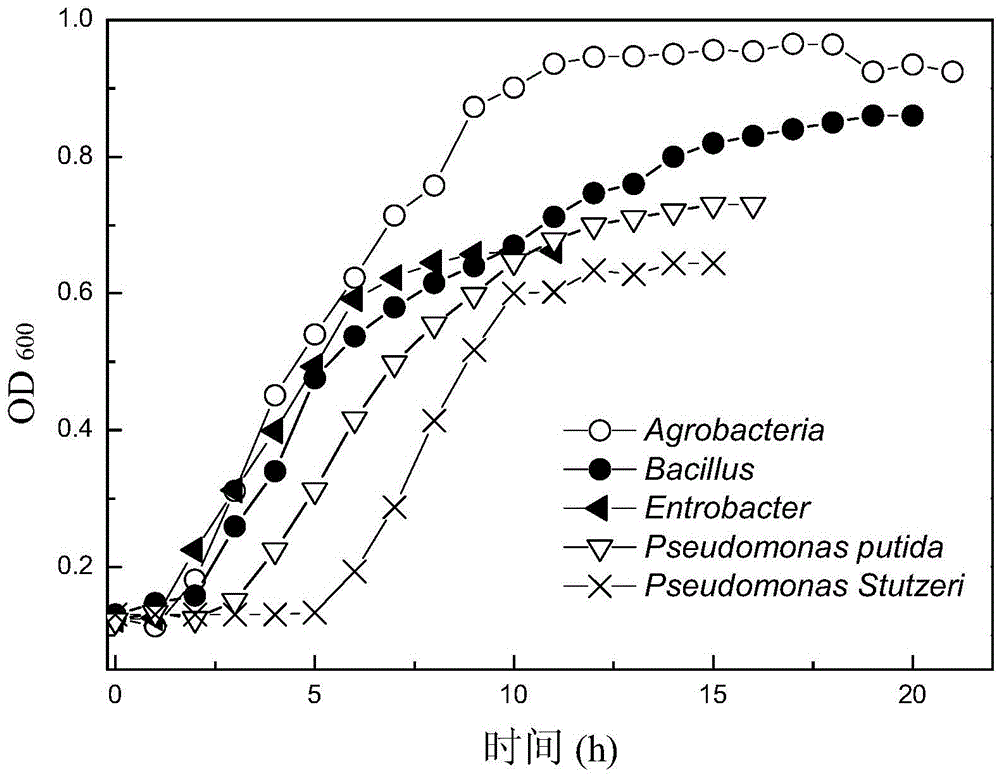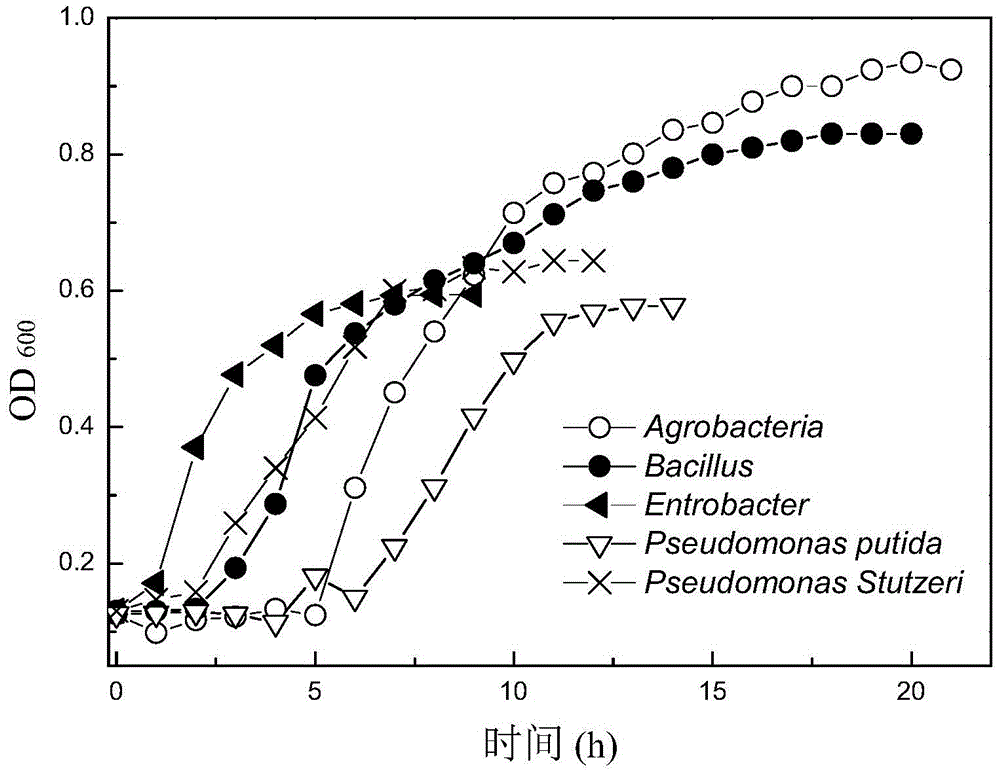A kind of composite bacterial flora for degrading papermaking wastewater and its preparation method
A technology for compound flora and papermaking wastewater, applied in the directions of microorganism-based methods, biochemical equipment and methods, chemical instruments and methods, etc.
- Summary
- Abstract
- Description
- Claims
- Application Information
AI Technical Summary
Problems solved by technology
Method used
Image
Examples
Embodiment 1
[0023]Pick Agrobacterium sp., Bacillus sp., Enterobacter.cloacae., Pseudomonasputida., Pseudomonasstutzeri. Separated from the sludge of the drainage outlet of the factory) five kinds of bacteria 1 ring: transfer them to 20mL nutrient solution (the composition is 1.5g / L beef extract, 1.0g / L glucose, 5.5g / L tryptone , 3.0g / L yeast powder, pH 6.5, and the rest is water), each kind of bacteria was cultured at 27°C for 2 days, and then the five cultured bacteria were cultured at a volume ratio of 1:9 (bacteria Cells and proliferation medium) were inoculated into a container containing 300mL of proliferation medium, cultured at 27°C for 2 days, and finally centrifuged at 6000rpm for 15min to obtain the logarithmic growth phase cells of the above five kinds of bacteria respectively. After washing with normal saline, dry and refrigerate for later use. Among them, five different bacteria use different proliferation media. The nutrient media of Agrobacterium, rod-shaped bacteria and E...
Embodiment 2
[0032] Pick two rings of five kinds of bacteria respectively: Agrobacteriumsp., Bacillussp., Enterobacter.Cloacae., Pseudomonasputida., Pseudomonas stutzeri ( Pseudomonasstutzeri.) (separated from the sludge at the outlet of the paper mill) were transferred to 30 mL of nutrient solution (the composition of which was 2.0 g / L beef extract, 1.5 g / L glucose, 6.5 g / L tryptone , 3.5g / L yeast powder, pH7.5, and the rest is water), each kind of bacteria was cultured at 30°C for 2 days, and then the cultured five kinds of bacteria were respectively mixed in a volume ratio of 1:10 ( Bacteria and proliferation medium) were inoculated into a container containing 500mL of proliferation medium, cultured at 35°C for 1 day, and finally centrifuged at 7000rpm for 10min to obtain the logarithmic growth phase cells of the above five kinds of bacteria , rinsed with saline, dried and refrigerated for later use. Among them, five different bacteria use different proliferation media. The nutrient me...
Embodiment 3
[0041] Pick two rings of five kinds of bacteria respectively: Agrobacteriumsp., Bacillussp., Enterobacter.Cloacae., Pseudomonasputida., Pseudomonas stutzeri ( Pseudomonasstutzeri.) (separated from the sludge at the outlet of the paper mill) were transferred to 25 mL of nutrient solution (the composition of which was 1.7 g / L beef extract, 2.0 g / L glucose, 6.0 g / L tryptone , 4.0g / L yeast powder, pH 7.0, and the rest is water), each kind of bacteria was cultured at 30°C for 2 days, and then the cultured five kinds of bacteria were respectively mixed in a volume ratio of 1:12 ( Bacteria and proliferation medium) were inoculated into a container containing 400mL of proliferation medium, cultured at 35°C for 2 days, and finally centrifuged at 7000rpm for 10min to obtain the logarithmic growth phase cells of the above five bacteria , rinsed with saline, dried and refrigerated for later use. Among them, five different bacteria adopt different proliferation media, among which the nutr...
PUM
 Login to View More
Login to View More Abstract
Description
Claims
Application Information
 Login to View More
Login to View More - R&D
- Intellectual Property
- Life Sciences
- Materials
- Tech Scout
- Unparalleled Data Quality
- Higher Quality Content
- 60% Fewer Hallucinations
Browse by: Latest US Patents, China's latest patents, Technical Efficacy Thesaurus, Application Domain, Technology Topic, Popular Technical Reports.
© 2025 PatSnap. All rights reserved.Legal|Privacy policy|Modern Slavery Act Transparency Statement|Sitemap|About US| Contact US: help@patsnap.com



